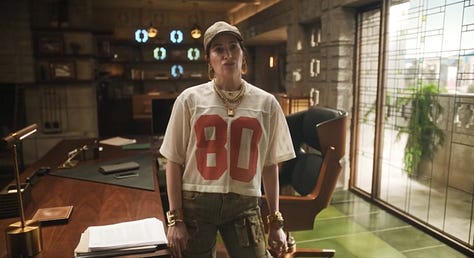Anatomy of a (oner) Scene: THE STUDIO
Though The Studio’s second episode got the most attention for its oner conceit, its not-really-a-pilot first episode “The Promotion” is shot in several long takes, moving from scene to scene with only a dozen or so cuts in total.
The oners often travel from location to location, which scenes often delineated by actors entering and exiting a scene — a technique often used in theatre, known as a ‘French scene’, and recently used by Adolescence. (If you’re interested how a stage manager may map French scenes, check this out.)
In addition to careful blocking and actors executing with precise timing, this necessitates plenty of specific camera operation.
Let’s look at how this scene with Matt (Seth Rogan) and Maya (Katherine Hahn) uses several camera techniques: rack focus; quick pans; blocking actors and camera in tandem; and transitioning into the next scene with the same actor.
Rack Focus
After some to-ing and fro-ing, Matt lands in the foreground, where he’s in focus as Maya waits in the background.
Maya may not be in focus, but she’s blocked close enough to the screen area where Matt is gesturing to be constantly in the back of our mind.
Then — after some delay tactics — Matt gives the punch line and sips his espresso, at which point the camera racks to Maya, signalling she’s who we should be paying attention to now . . .
After a beat — whether for Katherine to ensure she’s in focus, or from Maya to make sure she gets the Most Dramatic Bang For Her Buck, but why not both? — Maya sweeps items off the desk and vaults into the ‘fight!’ section of the scene.
Quick Pan
While elsewhere in this episode whip-pans could conceivably be used to cover cuts, this pan is about the visual gag.
The camera move is teed up by Matt’s look; the camera swings to see what he’s looking at, he says “everyone’s watching!” as the camera lands just in time to catch everyone staring, then immediately-pretend-to-be-busy-and-not-watching, at which point the camera pans back to Matt and Maya.
Big camera moves can too easily start distracting from the scenes — especially if you’re not going full hyper-meta Arrested Development, or embracing Abbott Elementary-style mockumentary which uses the camera as an acknowledged part of the world along with with talking head interviews, and characters referencing both camera and crew.
But used sparingly and timed perfectly, these kinds of sight gags are great mini-’breaks’ within your oners.
Blocking with Camera
The actors and camera move sometimes together, sometimes only one, sometimes neither. In addition to using that flow to create momentum, you need to consider how each of your ‘still’ shots work on their own. Just because you move into them instead of edit into them doesn’t mean shot composition can go out the window; in fact, like with the rack above, it’s very important.
Here’s a composition example: Maya and Matt argue, then as Maya warms to her subject — so warm she sheds the puffer vest — they move around the desk into a very similar shot, on opposite sides of frame.
The two still'-ish frames literally switch their positions as they try to change each others’ position.
Scene Transition
When you’re working with oners instead of coverage, your only option to change your end and start shot is to cut in later or earlier. Planning how scenes transition and what they cut from and to is vital.
Could you cut from Maya to Maya in a different outfit to signal passage of time? Technically yes. Should you? Definitely no; it’s more likely to confuse than anything.
Instead, cut from Maya to a KoolAid poster, which Maya then swans in front of.



We still get the same information of ‘time jump’ through Maya’s significant hair / wardrobe change, but instead of a jarring smash cut, the scene transition lands a double comedy beat.
(I absolutely let the clip run a beat longer than required — the better to appreciate Hahn’s delivery of ‘skenario’)
Takeaways
A good oner isn’t just about ‘keeping the camera rolling,’ it takes into consideration how to direct the audience’s eyes, visual gags, the same kind of blocking overlap and reversal that more typically-edited scenes do, and how every scene transition works.
It’s stressful and ridiculous and likely to give cast and crew alike a series of tiny panic attacks, before giving the audience a similar feeling. But when you can pull off all that careful planning and get to the end successfully? It’s a feat like no other!




